South Africa’s culture is one of the most diverse in the world and has given rise to the term “Rainbow Nation”.
With 11 official languages and 8 other recognised languages, the rich culture of each of these groups brings its own vibrancy to our diversity.
How did we get so many different cultures in one country?
The original aboriginal peoples living here were the KhoiKhoi and San. They were joined by two main migrations – that of the Bantu peoples from the north in Africa and the colonisation by the Europeans from the south, all bringing their own cultures, skills, arts and farming methods with them.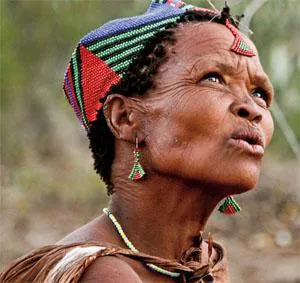
KhoiKhoi and San culture in South Africa
The indigenous KhoiKhoi and San were the early artists of South Africa as can be seen in the wonderful rock art across the country. The San, known as “Bushmen” were extraordinary hunters and trackers, and their tracking skills are still invaluable in the fight against poachers.
Today, their language is under threat, as is their nomadic way of life in the desert regions of the country. Organisations are at work to try and preserve this special culture with projects like bringing the language back into the school curriculum.
The Bantu migrants were not all of the same culture; there were the Zulu, Xhosa, Sotho, Ndebele, Shangaan and Venda to name a few, each with their own colourful and interesting way of life. It is a popular tourist attraction to see these traditional cultures with their interesting homes, dress, wonderful beadwork, pottery, arts & crafts and cultural events in the rural areas.
Zulu culture in South Africa
The Zulu traditional culture was well known for the ferocity of its shield bearing warriors, especially under Shaka; for its beadwork and basketry and the beehive grass huts that pepper the KwaZulu-Natal hills.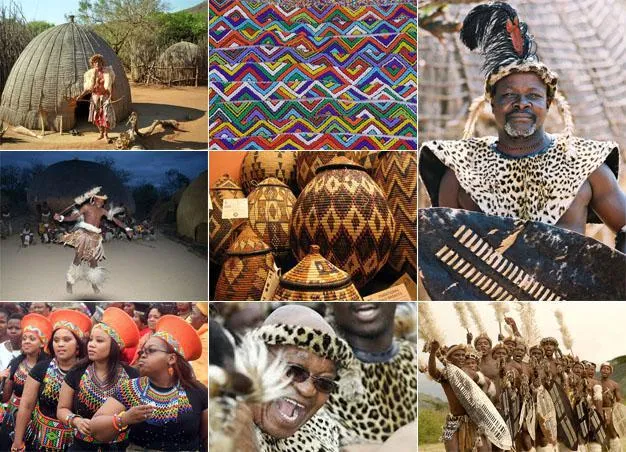
Zulu beliefs are based on the presence of ancestral spirits, which often appear in dreams, and a supreme being who is seldom involved in the affairs of mortals. Magic is used and many cases of illness or bad luck are considered to be caused by an evil spirit. A diviner will communicate with the spirits or use natural herbs and prayers to get rid of the problem.
Xhosa culture in South Africa

Search
Go
☰ Menu
South African Culture
South Africa’s culture is one of the most diverse in the world and has given rise to the term “Rainbow Nation”.
With 11 official languages and 8 other recognised languages, the rich culture of each of these groups brings its own vibrancy to our diversity.
How did we get so many different cultures in one country?
The original aboriginal peoples living here were the KhoiKhoi and San. They were joined by two main migrations – that of the Bantu peoples from the north in Africa and the colonisation by the Europeans from the south, all bringing their own cultures, skills, arts and farming methods with them.
Khoisan WomanKhoiKhoi and San culture in South Africa
The indigenous KhoiKhoi and San were the early artists of South Africa as can be seen in the wonderful rock art across the country. The San, known as “Bushmen” were extraordinary hunters and trackers, and their tracking skills are still invaluable in the fight against poachers.
Today, their language is under threat, as is their nomadic way of life in the desert regions of the country. Organisations are at work to try and preserve this special culture with projects like bringing the language back into the school curriculum.
The Bantu migrants were not all of the same culture; there were the Zulu, Xhosa, Sotho, Ndebele, Shangaan and Venda to name a few, each with their own colourful and interesting way of life. It is a popular tourist attraction to see these traditional cultures with their interesting homes, dress, wonderful beadwork, pottery, arts & crafts and cultural events in the rural areas.
Zulu culture in South Africa
The Zulu traditional culture was well known for the ferocity of its shield bearing warriors, especially under Shaka; for its beadwork and basketry and the beehive grass huts that pepper the KwaZulu-Natal hills.
The Zulus Traditional Culture
Zulu beliefs are based on the presence of ancestral spirits, which often appear in dreams, and a supreme being who is seldom involved in the affairs of mortals. Magic is used and many cases of illness or bad luck are considered to be caused by an evil spirit. A diviner will communicate with the spirits or use natural herbs and prayers to get rid of the problem.
Xhosa culture in South Africa
Xhosa culture in South Africa
The Xhosa culture is well known for the complex dress code that indicates a person’s social standing. How senior they are, if they are married or single, if they are the new wife or have had a baby – all shown in the headdress and dress of the wearer. A combination of a long skirt with no slit in front, together with a marriage bib and two beaded aprons means the wearer is a widow. The more elaborate the hat, the more senior the wearer. Only young girls may go around bare-breasted. The pipe smoking of Xhosa women is also well known and a huge variety of beaded pipes abound. Traditionalists were described as ‘Red’ because of their practice of daubing (ukuqaba) red clay on their faces and bodies. Women and men also use cosmetic white clay on their faces.
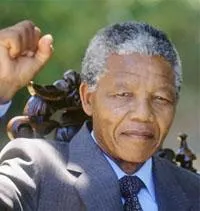
The Xhosas have a strong oral tradition with many stories of ancestral heroes. Ancestor worship rituals as well as the initiation ceremony for young men are still practised, even though many young men die or are mutilated by the circumcision.
Stick fighting is a common pastime for men, whose day time job is looking after the cattle. Women tend the crops, and do much of the other work around the home.
It was Xhosa leaders who initiated the fight against apartheid and founded the ANC. Among these were two of our modern day heroes, Nelson Mandela and Desmond Tutu
Ndebele culture in South Africa
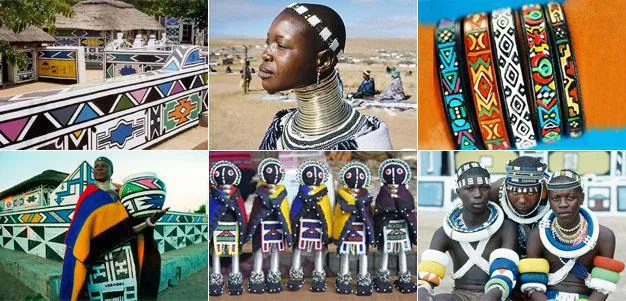
The Ndebele culture is renowned for the skill of the women who decorate their homes in vibrant geometric designs. Skills are passed from mother to daughter and the shapes used are often inspired by their intricately fashioned beadwork. Ndebele woman wear neck rings and traditional blankets of striking colours.
Sotho culture in South Africa and Lesotho
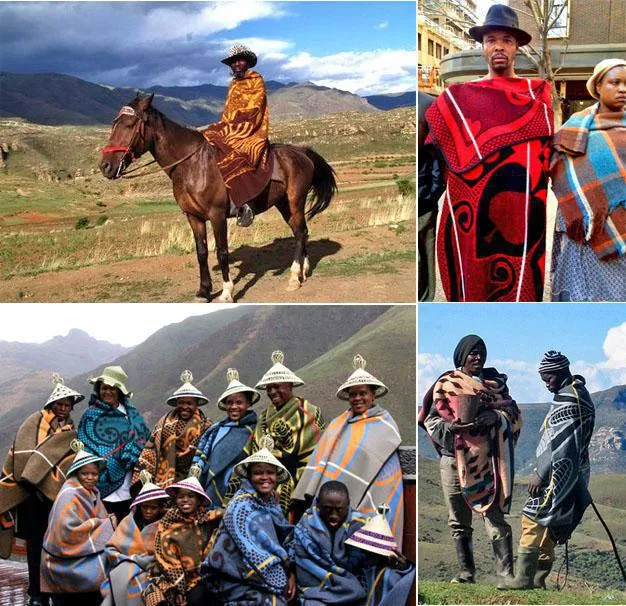
The Sotho groups of the South Sotho, Pedi and Tswana have some major cultural differences from the Nguni group (Zulu, Xhosa, Ndebele and Swazi), especially with respect to how they organise their villages and their marriages. The Sotho peoples tend to organise their homes into villages, rather than scattered settlements. In Nguni society, marriages to kin is frowned on while the Sotho will seek brides from kin, notably cousins on the maternal side.
The Nguni are grouped in clans, while totems, or praise-names taken from animals, distinguish the Sotho-speakers.
Sotho villages were also organized into age-sets, or groups of men or women who were close in age. Each age-set had specific responsibilities e.g. men organized for warfare and herding. An entire age-set generally graduated from one task to the next, and the village often celebrated this change with a series of rituals and, in some cases, an initiation ceremony. In the past initiations into adulthood were elaborate ceremonies lasting a few months, in which girls and boys were taken separately to the bush in the winter. The boys were circumcised. Increasingly, funerals have become the most elaborate life-cycle rituals.
The South Sotho people of Lesotho (baSuto) are identified with the brightly colored blankets that they often wear instead of coats. These blankets have designs picturing everything from airplanes to crowns to geometric patterns. The blankets are store-bought—there is no tradition of making them locally.
Traditions of folk art include beadwork, sewing, pottery making, house decoration, and weaving. Functional items such as sleeping mats, baskets, and beer strainers continue to be woven by hand from grass materials. Folk craft traditions have been revived and modified in response to the tourist trade.
The Shangaan culture in South Africa
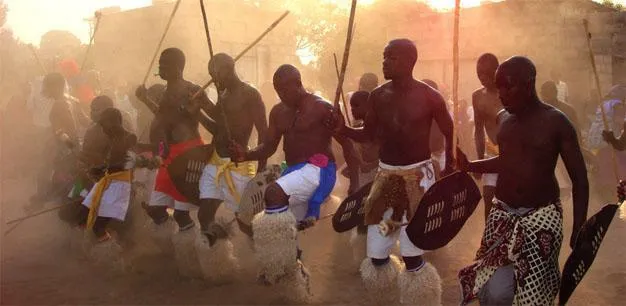
The Shangaan people are located mainly in the area of the Kruger Park in Mpumalanga. Their culture is of mixed ancestry and was brought about due to the military actions of Soshangane, one of Shaka’s generals who fell into disfavour. To escape Shaka, Soshangane fled north, through Swaziland, finally settling in Mozambique. His men found wives among the locals – among them Tsongas – and thus the Shangaan people were established.
Soshangane imposed the strict Zulu military system and tribal wear on Shangaan traditions, but retained the beautiful Tsonga homesteads that include round huts with patterned thatch roofs. He also incorporated their love of music that features a variety of ingenious stringed, wind and percussion instruments.
The Shangaan people, through Tsonga influence, are one of the few ethnic groups in South Africa to practice fishing and include fish in their diet. Because of the wealth of game in the area they also enjoy venison and crocodile, which they bake in a delicious groundnut (peanut) sauce.
The most unusual aspect of their diet, however, is their love of the mopani worm found in the mopani forests of the Lowveld. These are either dried or pan fried in butter, which is an experience no adventurous traveller should miss.
An important figure in traditional Shangaan culture, as with all the Nguni peoples of south eastern Africa, is the Sangoma, a healer and spiritual guide. The Sangoma’s medicine gourd, has become a symbol of the traditional cultural heritage of the Shangaan.
The Venda culture in South Africa
The Soutpansberg Mountains of the Limpopo Province in South Africa is the home of the Venda people, the smallest of the South Africa cultures.
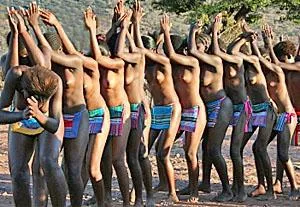
ShowMe https://showme.co.za
South Africa
Search
Go
☰ Menu
South African Culture
South Africa’s culture is one of the most diverse in the world and has given rise to the term “Rainbow Nation”.
With 11 official languages and 8 other recognised languages, the rich culture of each of these groups brings its own vibrancy to our diversity.
How did we get so many different cultures in one country?
The original aboriginal peoples living here were the KhoiKhoi and San. They were joined by two main migrations – that of the Bantu peoples from the north in Africa and the colonisation by the Europeans from the south, all bringing their own cultures, skills, arts and farming methods with them.
Khoisan WomanKhoiKhoi and San culture in South Africa
The indigenous KhoiKhoi and San were the early artists of South Africa as can be seen in the wonderful rock art across the country. The San, known as “Bushmen” were extraordinary hunters and trackers, and their tracking skills are still invaluable in the fight against poachers.
Today, their language is under threat, as is their nomadic way of life in the desert regions of the country. Organisations are at work to try and preserve this special culture with projects like bringing the language back into the school curriculum.
The Bantu migrants were not all of the same culture; there were the Zulu, Xhosa, Sotho, Ndebele, Shangaan and Venda to name a few, each with their own colourful and interesting way of life. It is a popular tourist attraction to see these traditional cultures with their interesting homes, dress, wonderful beadwork, pottery, arts & crafts and cultural events in the rural areas.
Zulu culture in South Africa
The Zulu traditional culture was well known for the ferocity of its shield bearing warriors, especially under Shaka; for its beadwork and basketry and the beehive grass huts that pepper the KwaZulu-Natal hills.
The Zulus Traditional Culture
Zulu beliefs are based on the presence of ancestral spirits, which often appear in dreams, and a supreme being who is seldom involved in the affairs of mortals. Magic is used and many cases of illness or bad luck are considered to be caused by an evil spirit. A diviner will communicate with the spirits or use natural herbs and prayers to get rid of the problem.
Xhosa culture in South Africa
Xhosa culture in South Africa
The Xhosa culture is well known for the complex dress code that indicates a person’s social standing. How senior they are, if they are married or single, if they are the new wife or have had a baby – all shown in the headdress and dress of the wearer. A combination of a long skirt with no slit in front, together with a marriage bib and two beaded aprons means the wearer is a widow. The more elaborate the hat, the more senior the wearer. Only young girls may go around bare-breasted. The pipe smoking of Xhosa women is also well known and a huge variety of beaded pipes abound. Traditionalists were described as ‘Red’ because of their practice of daubing (ukuqaba) red clay on their faces and bodies. Women and men also use cosmetic white clay on their faces.
Nelson MandelaThe Xhosas have a strong oral tradition with many stories of ancestral heroes. Ancestor worship rituals as well as the initiation ceremony for young men are still practised, even though many young men die or are mutilated by the circumcision.
Stick fighting is a common pastime for men, whose day time job is looking after the cattle. Women tend the crops, and do much of the other work around the home.
It was Xhosa leaders who initiated the fight against apartheid and founded the ANC. Among these were two of our modern day heroes, Nelson Mandela and Desmond Tutu.
Ndebele culture in South Africa
Ndebele Culture in South Africa
The Ndebele culture is renowned for the skill of the women who decorate their homes in vibrant geometric designs. Skills are passed from mother to daughter and the shapes used are often inspired by their intricately fashioned beadwork. Ndebele woman wear neck rings and traditional blankets of striking colours.
Sotho culture in South Africa and Lesotho
Sotho culture in South Africa and Lesotho
The Sotho groups of the South Sotho, Pedi and Tswana have some major cultural differences from the Nguni group (Zulu, Xhosa, Ndebele and Swazi), especially with respect to how they organise their villages and their marriages. The Sotho peoples tend to organise their homes into villages, rather than scattered settlements. In Nguni society, marriages to kin is frowned on while the Sotho will seek brides from kin, notably cousins on the maternal side.
The Nguni are grouped in clans, while totems, or praise-names taken from animals, distinguish the Sotho-speakers.
Sotho villages were also organized into age-sets, or groups of men or women who were close in age. Each age-set had specific responsibilities e.g. men organized for warfare and herding. An entire age-set generally graduated from one task to the next, and the village often celebrated this change with a series of rituals and, in some cases, an initiation ceremony. In the past initiations into adulthood were elaborate ceremonies lasting a few months, in which girls and boys were taken separately to the bush in the winter. The boys were circumcised. Increasingly, funerals have become the most elaborate life-cycle rituals.
The South Sotho people of Lesotho (baSuto) are identified with the brightly colored blankets that they often wear instead of coats. These blankets have designs picturing everything from airplanes to crowns to geometric patterns. The blankets are store-bought—there is no tradition of making them locally.
Traditions of folk art include beadwork, sewing, pottery making, house decoration, and weaving. Functional items such as sleeping mats, baskets, and beer strainers continue to be woven by hand from grass materials. Folk craft traditions have been revived and modified in response to the tourist trade.
The Shangaan culture in South Africa
Shangaan traditional dancing
The Shangaan people are located mainly in the area of the Kruger Park in Mpumalanga. Their culture is of mixed ancestry and was brought about due to the military actions of Soshangane, one of Shaka’s generals who fell into disfavour. To escape Shaka, Soshangane fled north, through Swaziland, finally settling in Mozambique. His men found wives among the locals – among them Tsongas – and thus the Shangaan people were established.
Soshangane imposed the strict Zulu military system and tribal wear on Shangaan traditions, but retained the beautiful Tsonga homesteads that include round huts with patterned thatch roofs. He also incorporated their love of music that features a variety of ingenious stringed, wind and percussion instruments.
The Shangaan people, through Tsonga influence, are one of the few ethnic groups in South Africa to practice fishing and include fish in their diet. Because of the wealth of game in the area they also enjoy venison and crocodile, which they bake in a delicious groundnut (peanut) sauce.
The most unusual aspect of their diet, however, is their love of the mopani worm found in the mopani forests of the Lowveld. These are either dried or pan fried in butter, which is an experience no adventurous traveller should miss.
An important figure in traditional Shangaan culture, as with all the Nguni peoples of south eastern Africa, is the Sangoma, a healer and spiritual guide. The Sangoma’s medicine gourd, has become a symbol of the traditional cultural heritage of the Shangaan.
The Venda culture in South Africa
The Soutpansberg Mountains of the Limpopo Province in South Africa is the home of the Venda people, the smallest of the South Africa cultures.
Venda Snake DanceThe Venda culture is built on a vibrant mythical belief system, and water is an import theme, believing lakes and rivers to be sacred, and that rains are controlled by the Python God. One of the most sacred sites of the Venda is Lake Fundudzi where annual rites are held. This is where the famous Domba Python Dance is held and young maidens, as the final stage of their initiation into womanhood, line up in single file and dance in long winding lines, like a snake. The Domba is also important to secure good rains for the following season.
The Sangoma or traditional healer is believed to have access to the spirits and seeks guidance from the ancestors. Many Venda consult a Sangoma if they became ill, who would diagnose the trouble in the spirit world which might be alleviated by a particular course of action and usually prescribes a course of herbs
ShowMe https://showme.co.za
South Africa
Search
Go
☰ Menu
South African Culture
South Africa’s culture is one of the most diverse in the world and has given rise to the term “Rainbow Nation”.
With 11 official languages and 8 other recognised languages, the rich culture of each of these groups brings its own vibrancy to our diversity.
How did we get so many different cultures in one country?
The original aboriginal peoples living here were the KhoiKhoi and San. They were joined by two main migrations – that of the Bantu peoples from the north in Africa and the colonisation by the Europeans from the south, all bringing their own cultures, skills, arts and farming methods with them.
Khoisan WomanKhoiKhoi and San culture in South Africa
The indigenous KhoiKhoi and San were the early artists of South Africa as can be seen in the wonderful rock art across the country. The San, known as “Bushmen” were extraordinary hunters and trackers, and their tracking skills are still invaluable in the fight against poachers.
Today, their language is under threat, as is their nomadic way of life in the desert regions of the country. Organisations are at work to try and preserve this special culture with projects like bringing the language back into the school curriculum.
The Bantu migrants were not all of the same culture; there were the Zulu, Xhosa, Sotho, Ndebele, Shangaan and Venda to name a few, each with their own colourful and interesting way of life. It is a popular tourist attraction to see these traditional cultures with their interesting homes, dress, wonderful beadwork, pottery, arts & crafts and cultural events in the rural areas.
Zulu culture in South Africa
The Zulu traditional culture was well known for the ferocity of its shield bearing warriors, especially under Shaka; for its beadwork and basketry and the beehive grass huts that pepper the KwaZulu-Natal hills.
The Zulus Traditional Culture
Zulu beliefs are based on the presence of ancestral spirits, which often appear in dreams, and a supreme being who is seldom involved in the affairs of mortals. Magic is used and many cases of illness or bad luck are considered to be caused by an evil spirit. A diviner will communicate with the spirits or use natural herbs and prayers to get rid of the problem.
Xhosa culture in South Africa
Xhosa culture in South Africa
The Xhosa culture is well known for the complex dress code that indicates a person’s social standing. How senior they are, if they are married or single, if they are the new wife or have had a baby – all shown in the headdress and dress of the wearer. A combination of a long skirt with no slit in front, together with a marriage bib and two beaded aprons means the wearer is a widow. The more elaborate the hat, the more senior the wearer. Only young girls may go around bare-breasted. The pipe smoking of Xhosa women is also well known and a huge variety of beaded pipes abound. Traditionalists were described as ‘Red’ because of their practice of daubing (ukuqaba) red clay on their faces and bodies. Women and men also use cosmetic white clay on their faces.
Nelson MandelaThe Xhosas have a strong oral tradition with many stories of ancestral heroes. Ancestor worship rituals as well as the initiation ceremony for young men are still practised, even though many young men die or are mutilated by the circumcision.
Stick fighting is a common pastime for men, whose day time job is looking after the cattle. Women tend the crops, and do much of the other work around the home.
It was Xhosa leaders who initiated the fight against apartheid and founded the ANC. Among these were two of our modern day heroes, Nelson Mandela and Desmond Tutu.
Ndebele culture in South Africa
Ndebele Culture in South Africa
The Ndebele culture is renowned for the skill of the women who decorate their homes in vibrant geometric designs. Skills are passed from mother to daughter and the shapes used are often inspired by their intricately fashioned beadwork. Ndebele woman wear neck rings and traditional blankets of striking colours.
Sotho culture in South Africa and Lesotho
Sotho culture in South Africa and Lesotho
The Sotho groups of the South Sotho, Pedi and Tswana have some major cultural differences from the Nguni group (Zulu, Xhosa, Ndebele and Swazi), especially with respect to how they organise their villages and their marriages. The Sotho peoples tend to organise their homes into villages, rather than scattered settlements. In Nguni society, marriages to kin is frowned on while the Sotho will seek brides from kin, notably cousins on the maternal side.
The Nguni are grouped in clans, while totems, or praise-names taken from animals, distinguish the Sotho-speakers.
Sotho villages were also organized into age-sets, or groups of men or women who were close in age. Each age-set had specific responsibilities e.g. men organized for warfare and herding. An entire age-set generally graduated from one task to the next, and the village often celebrated this change with a series of rituals and, in some cases, an initiation ceremony. In the past initiations into adulthood were elaborate ceremonies lasting a few months, in which girls and boys were taken separately to the bush in the winter. The boys were circumcised. Increasingly, funerals have become the most elaborate life-cycle rituals.
The South Sotho people of Lesotho (baSuto) are identified with the brightly colored blankets that they often wear instead of coats. These blankets have designs picturing everything from airplanes to crowns to geometric patterns. The blankets are store-bought—there is no tradition of making them locally.
Traditions of folk art include beadwork, sewing, pottery making, house decoration, and weaving. Functional items such as sleeping mats, baskets, and beer strainers continue to be woven by hand from grass materials. Folk craft traditions have been revived and modified in response to the tourist trade.
The Shangaan culture in South Africa
Shangaan traditional dancing
The Shangaan people are located mainly in the area of the Kruger Park in Mpumalanga. Their culture is of mixed ancestry and was brought about due to the military actions of Soshangane, one of Shaka’s generals who fell into disfavour. To escape Shaka, Soshangane fled north, through Swaziland, finally settling in Mozambique. His men found wives among the locals – among them Tsongas – and thus the Shangaan people were established.
Soshangane imposed the strict Zulu military system and tribal wear on Shangaan traditions, but retained the beautiful Tsonga homesteads that include round huts with patterned thatch roofs. He also incorporated their love of music that features a variety of ingenious stringed, wind and percussion instruments.
The Shangaan people, through Tsonga influence, are one of the few ethnic groups in South Africa to practice fishing and include fish in their diet. Because of the wealth of game in the area they also enjoy venison and crocodile, which they bake in a delicious groundnut (peanut) sauce.
The most unusual aspect of their diet, however, is their love of the mopani worm found in the mopani forests of the Lowveld. These are either dried or pan fried in butter, which is an experience no adventurous traveller should miss.
An important figure in traditional Shangaan culture, as with all the Nguni peoples of south eastern Africa, is the Sangoma, a healer and spiritual guide. The Sangoma’s medicine gourd, has become a symbol of the traditional cultural heritage of the Shangaan.
The Venda culture in South Africa
The Soutpansberg Mountains of the Limpopo Province in South Africa is the home of the Venda people, the smallest of the South Africa cultures.
Venda Snake DanceThe Venda culture is built on a vibrant mythical belief system, and water is an import theme, believing lakes and rivers to be sacred, and that rains are controlled by the Python God. One of the most sacred sites of the Venda is Lake Fundudzi where annual rites are held. This is where the famous Domba Python Dance is held and young maidens, as the final stage of their initiation into womanhood, line up in single file and dance in long winding lines, like a snake. The Domba is also important to secure good rains for the following season.
The Sangoma or traditional healer is believed to have access to the spirits and seeks guidance from the ancestors. Many Venda consult a Sangoma if they became ill, who would diagnose the trouble in the spirit world which might be alleviated by a particular course of action and usually prescribes a course of herbs.
Venda decorated potsBeliefs in the spirit world influence the Venda art – their woodcarvings, pottery and the decoration of their buildings. Drums are central in the culture and there are legends and symbols linked to them.
In rural areas cattle mean wealth, and the lifestyle revolves around agriculture. Male and female roles are clearly defined, with the men responsible for livestock, ploughing and the building of huts, while the women do most of the harvesting as well as all the domestic duties. Polygamy is still common, and due to the prosperity of the farmland, fewer men leave the area to work in the mines than is the case with many other tribes. As a result, traditional life has changed little over the years.

To be continued..........................